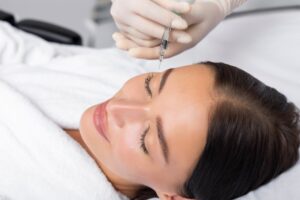 My latest issue of Plastic and Reconstructive Surgery Journal had a special edition on Botox and “neuromodulators.” Most of it was not new news, but I was interested in one journal article talking about “Using Neuromodulators to Improve Scar Formation, Keloids, Rosacea, and Antiaging.”
My latest issue of Plastic and Reconstructive Surgery Journal had a special edition on Botox and “neuromodulators.” Most of it was not new news, but I was interested in one journal article talking about “Using Neuromodulators to Improve Scar Formation, Keloids, Rosacea, and Antiaging.”
Hmm.
I know it helps with scars. See my prior blogs on Botox and keloids. But Antiaging? Rosacea?
For antiaging, they discuss that aging is a complex process that involves environmental and physiologic factors. There are many that advocate that doing Botox helps skin changes over time and improves the skin quality “independent of the direct effect on the musculature improving the appearance of the overlying rhytids.”
What does that mean? It means that they are stating that the skin improvement in wrinkles is NOT just because it relaxes the muscles, but that there is some X factor by using Botox that helps skin quality.
Why would that be?
They postulate that clinical and invitro studies have identified changes in the skin structural components, enzymes, skin pores, procollagen II, Collagen I, Collagen III, and fibroblasts. They asses the skin on multiple features: radiance, texture smoothness, pore visibility, and luminosity. They try to make these vague terms like “radiance” medical by using tools like dermoscopes and 3D imaging and photographic scales to make it more objective.
What do studies show?
- One study looked at Botox injections vs. Saline (water) injections. Both groups showed neocollagen synthesis. They conclude: the NEEDLE PRICK improved the skin, not what was injected. (Huge plug for microneedling! which we offer in our clinic)
- Another study looked at pore size. Studies show that botox affects the sebaceous glands receptors, and botox blocks sebum production, causing a decrease in pore size.
- UV induces premature aging in fibroblasts. In vitro studies showed Botox treatment patients had an increase in Type I and Type III collagen, and a decrease in metalloproteinases. They state this supports the potential to activate fibroblasts affected by chronic photodamage.
When they look at treatment efficacy, there are some studies.
- One study compared intradermal and intramuscular botox treatments effect on skin texture and midface lift changes. They found statistically significant antiaging in skin texture and mild midface lift.
- Another prospective study used electron microscopes to evaluate skin texture changes following botox. They found at 1 month there were improved skin texture changes, but the changes appear to have reverted 6 months post treatment.
- Another study looked at skin elasticity and pliability. A prospective case series of 40 women found increased pliability and elasticity recoil.
- Another study showed improved elastcity, skin hydration, smoothness, and improved transepidermal water loss.
- Collagen synthesis and fibroblast activation has been shown, but again, that study was thought to be due to the needle prick, not the actual botox. GO MICRONEEDLING! MICRONEEDLING
In their conclusion, they state that the changes seem to revert by 6 months. The authors think that they do see long acting changes in skin texture, radiance, and luminosity.
My thoughts?
I think Botox is great. I’ve used it personally for 20+ years (yes, I am that old). But I have an issue with those that think Botox is preventative. Reading this article indicates maybe there is some “other” effect, but no great studies supporting it yet.
My takeaways?
First, when they looked at the changes which occurred at 1 month they were gone at 6 months. That is a temporary change while the Botox is in effect, not a permanent change.
Second, the true changes in collagen and fibroblasts seen were equal when injecting Botox or saline. They postulate the improvement is from doing the tiny needle sticks. Another round about way of supporting the skin changes seen in microneedling. I believe in microneedling. We do ours without radiofrequency on purpose (don’t want to lose any facial fat and volume!). We see great results.
The information provided on this website is for general informational purposes only and does not constitute medical advice, diagnosis, or treatment. Always seek the advice of a qualified healthcare provider for any questions regarding your health or medical condition.
